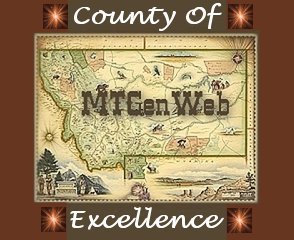 |
Addresses
Cemeteries
Churches
Communities & Towns
County Records
Family Group Sheets
Funeral Homes
Historic Places & Landmarks
Lookups & Volunteers
Obituaries
Park County Area Newspapes
Photo Gallery
Queries
MTGenWeb Counties
Montana Links
Neighboring Counties
Park County Government
Park County USGenWeb Archives
Park County Mail List
Park County Mail List Archives
Genealogy Look Up Forum
Park County History
Park County was named because of a small area of Yellowstone National Park being in the county. It was created on February 23, 1887 by the territorial legislature. After Lewis and Clark, the area was actively trapped by hundreds of men, mainly for beaver. In the decades starting 1840 and 1850, the trapping activity largely ceased because of lack of beaver demand due to the changed styles and the country being trapped out. Then gold was discovered in Emigrant Gulch in 1863. By the fall of 1864, several hundred men were working claims there. When winter came, 75 log huts were built at the mouth of the gulch and the town named Yellowstone City. In 1864, John Bozeman opened up the new road bearing his name to shorten, by several hundred miles, the route between Fort Laramie and the gold localities of Western Montana. The road passed through the Livingston area and then out over Bozeman Pass. In the mid-1860s, there was much travel going east. The almost complete lack of roads in the territory led to the use of the rivers, including the Yellowstone, as routes. The Livingston area was an embarkation point for hundreds of people prepared to risk the hazards of the river and Indians in mackinaw boats. Much of the lumber came from the first saw mill in the area on Mill Creek. In 1865 one fleet of 42 mackinaws left the boat yard on September 27. A year later a fleet of 16 mackinaw boats left the Livingston area with 250 miners carrying $500,000 in gold. They made the 2700 mile trip to St. Joseph in 28 days. In 1864 Hunter’s Hot Springs was discovered by Dr. Hunter and his party, passing through. Dr. Hunter returned six years later, built a house and took residence, in spite of Indian dangers. Later, the area was famous as a resort for many years. In 1868, in accordance with the Crow Treaty of that year, an Indian agency was established on the Crow reservation on Mission Creek. It was considered the finest fort in the territory, fully stockaded, blockhouses on the corners, etc. The requirements of the Fort for supplies caused a ferry to be set up across the Yellowstone River four miles east of the present site of Livingston. A small settlement, known as Benson’s landing, grew up here. For many years, it was the focal point of the area with some log houses, a hotel, several saloons, etc. It served as a stage stop, trading post and post office. For years the area of Yellowstone Park was almost completely unknown. The stories told over the years by Jim Bridger, traders and the Indians were received increduously. The place was known as “Colter’s Hell” from Colter’s stories of his winter there in 1807-1808. In 1869, the first real exploring party entered the Park area, followed by the Washburn party of 1870 and Hayden party of 1871. This led to the creation by Congress of the country’s first national park in 1872. By 1880, the population for the county was only about 200. In 1881, the Northern Pacific Railroad, building a line westward, entered the state of Montana. Livingston was reached November 22, 1882 where a settlement of 500 people had sprung up, awaiting the railroad. In 1883, the National Park branch of the NP Railroad was completed and the east west sections of the railroad joined together near Garrison, this opened up the entire country. |
Try the Park County site search engine! Just enter the keyword and click on find.
|
 |
Would you like to do lookups for Park County? Or maybe just type some information? Read a cemetery? No information is too small or trivial. Just contact Alicia to have your name added to the volunteer list. |
| Your Park County MTGenWeb Coordinator is Alicia Littlejohn. I hope you enjoy your visit. Drop me a line and let me know what you think of this site.....your likes and dislikes, what you would like to see added in the future, and any information you would like to contribute. No information is too small to be of possible help to your fellow researchers. Many thanks to previous county coordinator, Kevin Haddenham for all his years of service to Park County MTGenWeb Project. |
| Notice to Webmasters: You may not copy and paste the information on any of the pages of this site onto another web page without first obtaining explicit permission to do so and without including the copyright notice. |

December, 2012 & June, 2014
Last updated: January 2, 2019
| Copyright © 2012 - 2019 by Alicia Littlejohn COPYRIGHT NOTICE Materials on this site are provided for the free use of persons who are researching their family history. Data may be freely used by non-commercial and/or completely free entities, as long as this message remains on all copied material. Any commercial use, without the prior consent of the host/author of the materials provided on this site, is prohibited. The electronic pages on this site may not be reproduced in any format for profit. |

